Pollution: Contamination of natural sources with unwanted substances.
Air Pollution
The presence of harmful substances in the air leads to pollution of the air. It can severely affect the health of living organisms and the quality of the environment.
What causes Air Pollution?
• Burning of Fossil Fuels – When coal and petroleum are burnt, they release sulphur and nitrogen oxides which are harmful agents. They also release unburnt carbon particles in the air called Hydrocarbons.
• Exhaust from Industries – The industries release harmful gases and smoke in the air that contains carbon monoxide and organic compounds that decrease the quality of the air.
• Mining – During the mining process harmful chemicals are released in the air that leads to air pollution.
• Indoor Activities – Cleaning agents and paints used in houses release harmful chemicals which pollutes the air
• Suspended Particulate Matter – The particles such as dust often remain suspended in the air and degrade its quality. SPM is one of the major causes of air pollution in the cities.
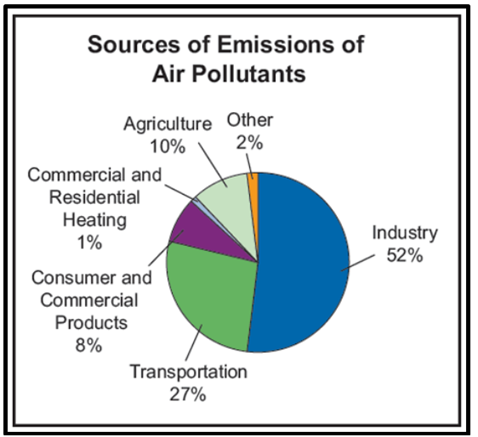
What are the effects of Air Pollution?
• Acid Rains – Rains often contain acidic compounds that can affect animals, plants and crops.
• Harmful diseases and allergies – Inhalation of harmful substances can lead to diseases such as heart problems and cancer and allergic reactions in the skin and eyes.
• A decrease in the visibility – The suspended particles in the air affects the visibility and also lead to the formation of smog in the cold weather.
• Global Warming – The temperature of the earth rises due to the presence of greenhouse gases in it such as carbon dioxide and methane.
• Ozone Layer Depletion - The air pollution leads to depletion of the outer covering of the ozone layer around the earth’s atmosphere.
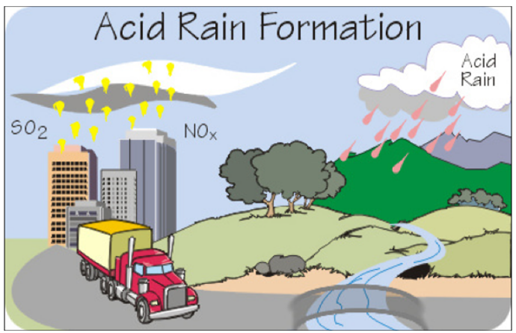
Water
The different forms of water present on the earth are:
• Water Vapour – found in the atmosphere
• Saline Water – found in seas and oceans
• Freshwater – found in frozen ice caps, snow-covered mountains, underground, rivers, lakes and ponds
Why Water is necessary for Life?
• The presence of water in a region decides the biodiversity of that area to a great extent.
• The cellular processes take place in the water-like-medium.
• A major constituent of blood is water which allows it to carry substances throughout the body.
• Water helps in regulating the body temperature in animals and human beings.
• It prevents the tissues, organs and cells from drying out by keeping them moist.
• Water helps in digestion of food.
• Water helps in the removal of waste products out of the cells.
• Plants also require water to transport food through different parts such as the stem and leaves and also in the process of photosynthesis.
Water Pollution
Water pollution occurs when harmful substances such as chemicals and waste materials like garbage are present in water that affect its quality and the presence of life in it.
Causes of Water Pollution
• Waste from Industries – The industries often release chemicals directly into water bodies such as rivers and seas which contaminates it.
• Sewage – The waste produced from households is often released into the water which gives rise to harmful bacteria in the water.
• Mining Activities – The metal wastes obtained from mining activities harm the organisms present in water
• Usage of Fertilizers and Pesticides – The chemicals present in fertilizers and pesticides are extremely harmful to aquatic animals, plants as well as animal consumption.
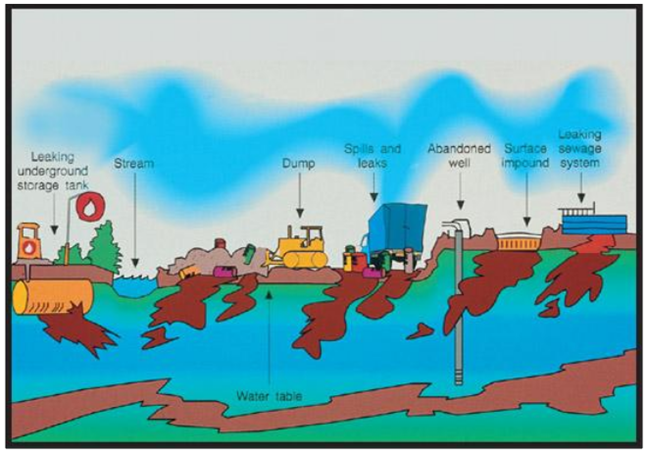
Effects of Water Pollution
• Addition of unwanted substances such as fertilizers pesticides and industrial wastes can make it poisonous and extremely harmful for consumption.
• It can also lead to an increase in bacteria that causes severe diseases like Cholera.
• Water pollution can lead to a decrease in the amount of Oxygen and nutrients in the water which affects the aquatic life.
• Water pollution can cause changes in the temperature of water. An increase in temperature is not suitable for all the aquatic animals especially their eggs.
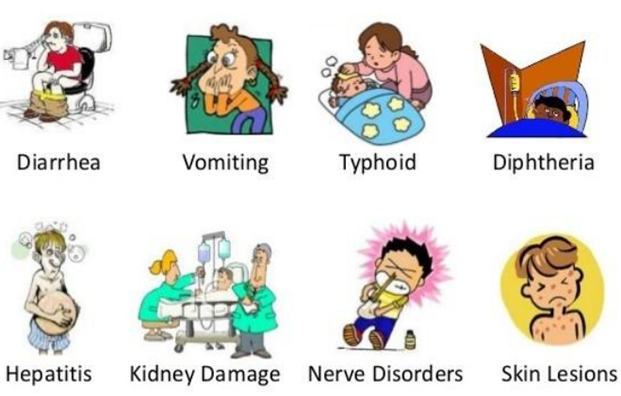
Ozone Layer Depletion
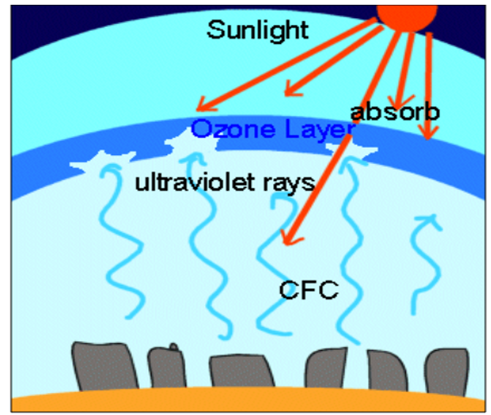
It has been discovered that the Ozone Layer is getting depleted from the earth's atmosphere. A hole in Ozone Layer has been found over Antarctica.
• This is mainly because of the presence of the Chlorofluorocarbons (CFCs) in the atmosphere. These are released due to industrial processes, refrigeration, aerosols, foams and solvents.
• The chlorine and fluorine present in these on reaching the Ozone Layer react with it to form complex compounds and it thus results in depletion of Ozone.
- If the Ozone Layer would deplete the ultraviolet rays of the sun would under the Earth’s atmosphere which could lead to severe effects such as:
• An increase in the risk of having skin cancer
• Damaging the eyes
• The weakening of the immune systems
• Skin allergies
• Decay in the growth of plants and animals
• Breakdown of the natural carbon cycle
Water harvesting
• Water harvesting is the collection of run off for productive purposes.
• Instead of run off being left to cause erosion, it is harvested and utilized.
• In the semi-arid drought-prone areas where it is already practiced, water harvesting is a directly productive form of soil and water conservation.
Eutrophication
• Eutrophication is the process in which a water body becomes overly enriched with nutrients, leading to plentiful growth of simple plant life.
• The excessive growth (or bloom) of algae and plankton in a water body are indicators of this process.
• Eutrophication is considered to be a serious environmental concern since it often results in the deterioration of water quality and the depletion of dissolved oxygen in water bodies.
• Eutrophic waters can eventually become “dead zones” that are incapable of supporting life.
Biological Magnification
Biomagnification can be defined as the rise or increase in the contaminated substances caused by the intoxicating environment. The contaminants might be heavy metals such as mercury, arsenic, and pesticides such as polychlorinated biphenyls and DDT.
Causes of biomagnification.
- Agriculture
The agricultural pesticides, insecticides, fertilizers and fungicides are very toxic and are released into the soil, rivers, lakes, and seas. These substances contain small amounts of heavy metals such as mercury, arsenic, copper, lead and cadmium. These cause health issues in aquatic organisms and humans.
- Organic Contaminants
Manures and biosolids are processed industrially and contain contaminants like pharmaceuticals and personal care products. These substances have an adverse impact on the health of humans, animals, and wildlife.
- Industrial Activities
The industries and factories release toxic substances that are released into the soil, lakes, oceans, and rivers. The gaseous emissions pollute the environment which enters into the food chain leading to biomagnification.
Effects of biomagnification on living organisms and the environment:
- Impact on Human Health
Biomagnification makes humans more prone to cancer, kidney problems, liver failure, birth defects, respiratory disorders, and heart diseases.
- Destruction of Coral reefs
Cyanide that is used in leaching gold and fishing is the main cause of the destruction of coral reefs. Coral reefs are the dwelling and feeding grounds for many sea creatures. Their destruction affects the lives of many aquatic animals.
- Disruption of Food Chain
The chemicals and toxins which are released into the water bodies disrupt the food chain. The small organisms absorb the toxins which are eaten up by larger animals. These toxins, thus, get accumulated in the higher level of organisms.

 Vaishnav Publication
Vaishnav Publication
